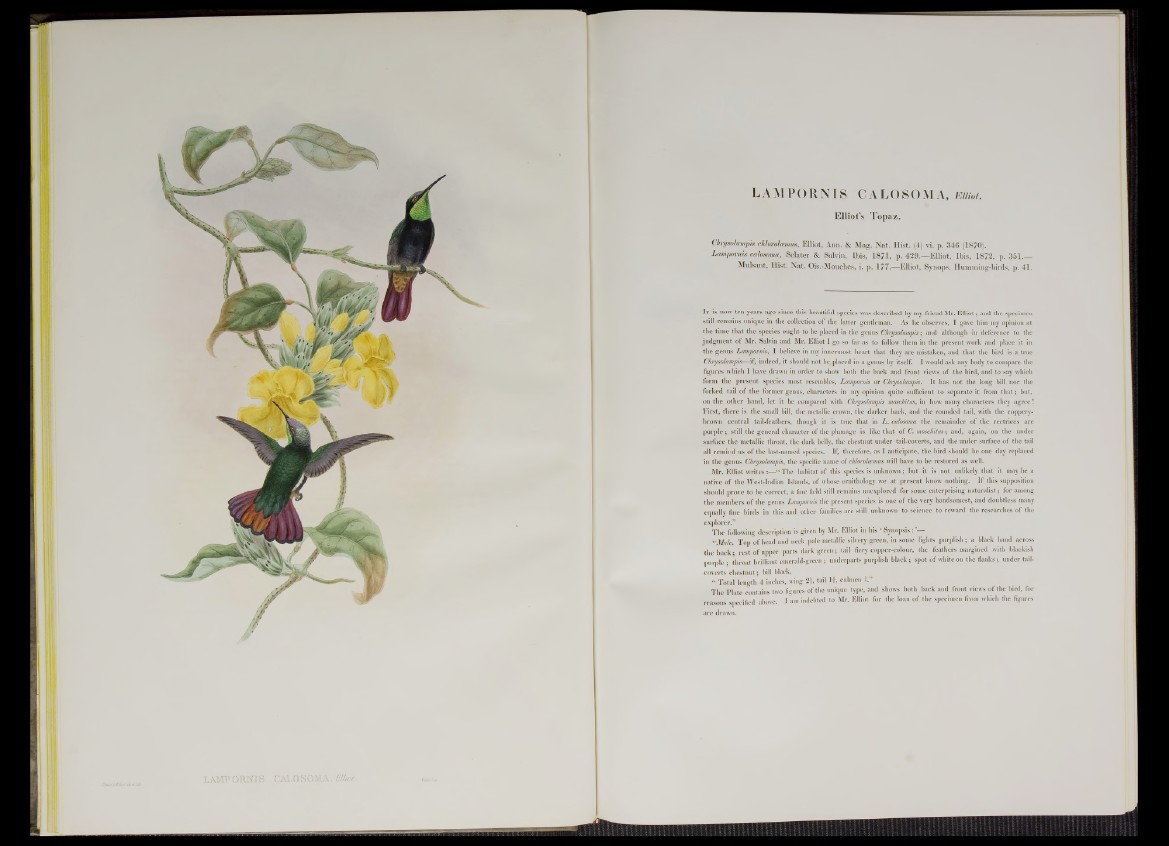
LAMPORNIS CALOSO
LAMPORNIS CALOSOMA, Elliot.
Elliot’s Topaz.
Chrysolampis chlorolamus, Elliot, Ann. & Mag. Nat. H ist. (4) vi. p. 3 4 6 (1870).
Lampornis calosoma, Sclater & Salvin, Ibis, 1 8 7 1 , p. 4 2 9 .— Elliot, Ibis, 1 8 7 2 , p. 3 5 1 .—
Mulsant, Hist. Nat. Ois.-Mouches, i. p. 1 7 7 .— Elliot, Synops. Humming-birds, p. 41.
I t is now ten years ago since this beautiful species was described by my friend Mr. Elliot; and the specimen
still remains unique in the collection of the latter gentleman. As he observes, I gave him my opinion at
the time that the species ought to be placed in the genus Chrysolampis; and although in deference to the
judgment o f Mr. Salvin and Mr. Elliot I go so far as to follow them in the present work and place it in
the genus Lampornis, I believe in my innermost heart that they are mistaken, and that the bird is a true
Chrysolampis—if, indeed, it should not be,placed iu a genus by itself. I would ask any body to compare the
figures which I have drawn in order to show both the back and front views of the bird, and to say which
form the present species most resembles, Lampornis or Chrysolampis. It has not the long bill nor the
forked tail o f the former genus, characters in my opinion quite sufficient to separate it from that; but,
on the other hand, let it be compared with Chrysolampis moschitus, in how many characters they agree!
First, there is the small bill, the metallic crown, the darker back, and the rounded tail, with the coppery-
brown central tail-feathers, though it is true that in L . calosoma the remainder of the rectrices are
purple ; still the general character of the plumage is like that of C. moschitus; and, again, on the under
surface the metallic throat, the dark belly, the chestnut under tail-coverts, aud the under surface o f the tail
all remind us of the last-named species. If, therefore, as I anticipate, the bird should be one day replaced
in the genus Chrysolampis, the specific name of chlorolamus will have to be restored as well.
Mr. Elliot writes:—“ The habitat of this species is unknown; but it is not unlikely that it may be a
native o f the West-Indian Islands, of whose ornithology we at present know nothing. If this supposition
should prove to be correct, a fine field still remains unexplored for some enterprising naturalist; for among
the members of the genus Lampornis the present species is one of the very handsomest, and doubtless many
equally fine birds in this and other families are still unknown to science to reward the researches of the
explorer.”
The following description is given by Mr. Elliot in his ‘ Synopsis:
“Male. Top o f head and neck pale metallic silvery green, in some lights purplish; a black band across
the back; rest of upper parts dark green; tail fiery copper-colour, the feathers margined with blackish
purple; throat brilliant emerald-green ; underparts purplish black; spot of white on the flanks; under tail-
coverts chestnut; bill black.
“ Total length 4 inches, wing ® | tail 11, culmen | | ”
The Plate contains two figures of the unique type, and shows both back and front views o f the bird, for
reasons specified above. I am indebted to Mr. Elliot for the loan of the specimen from which the figures
are drawn.